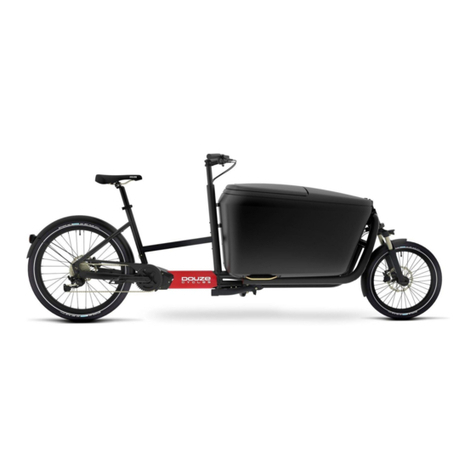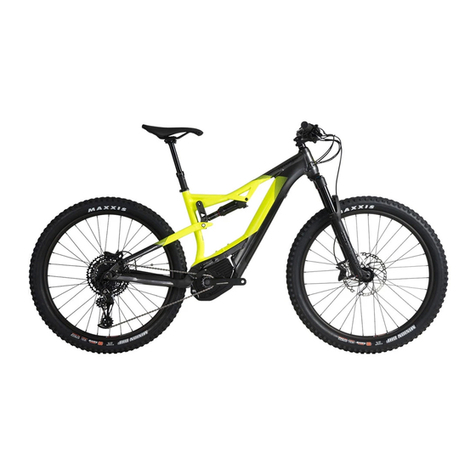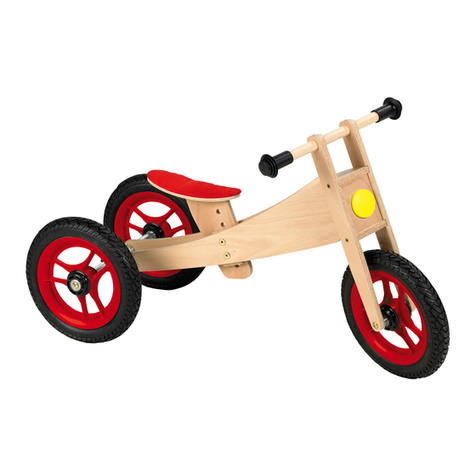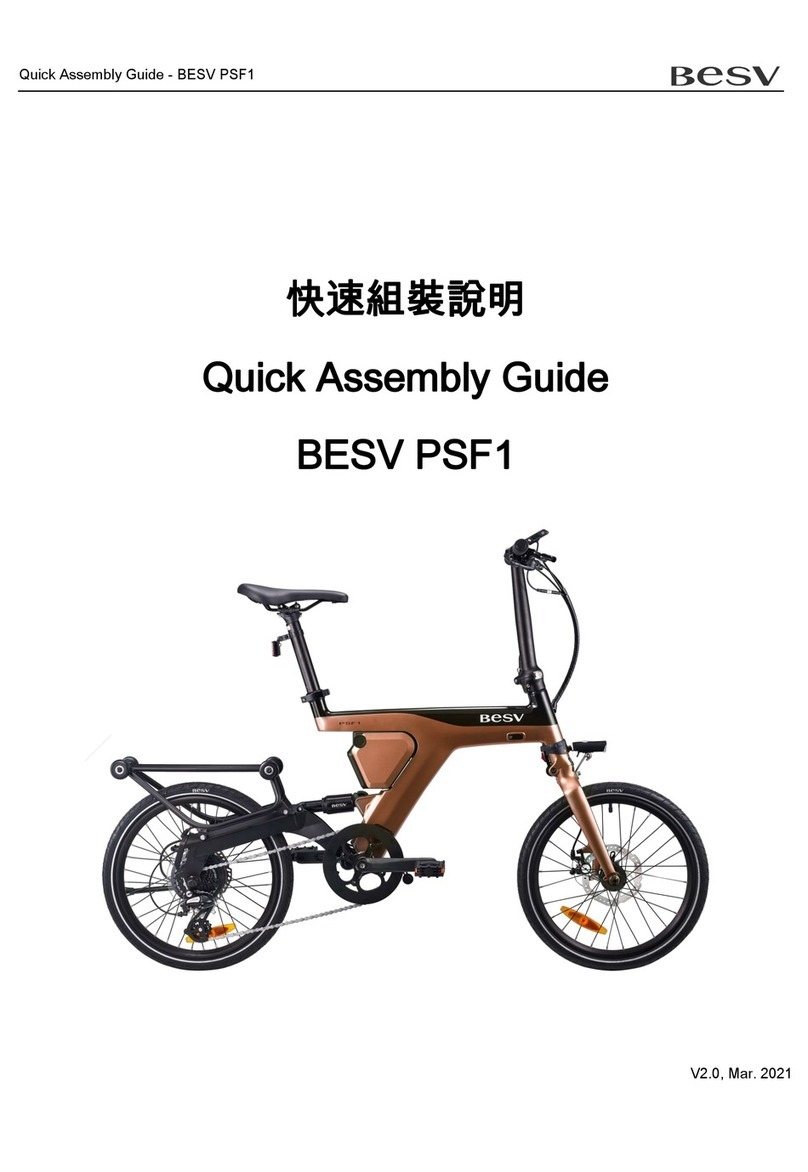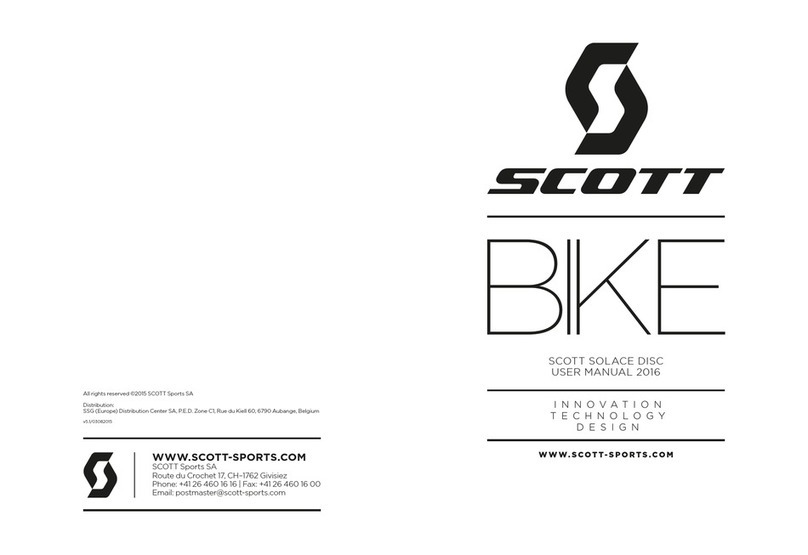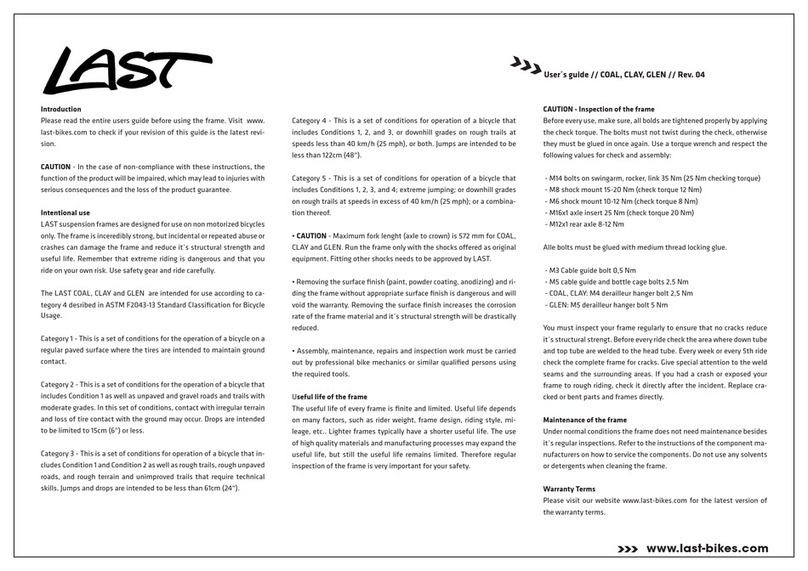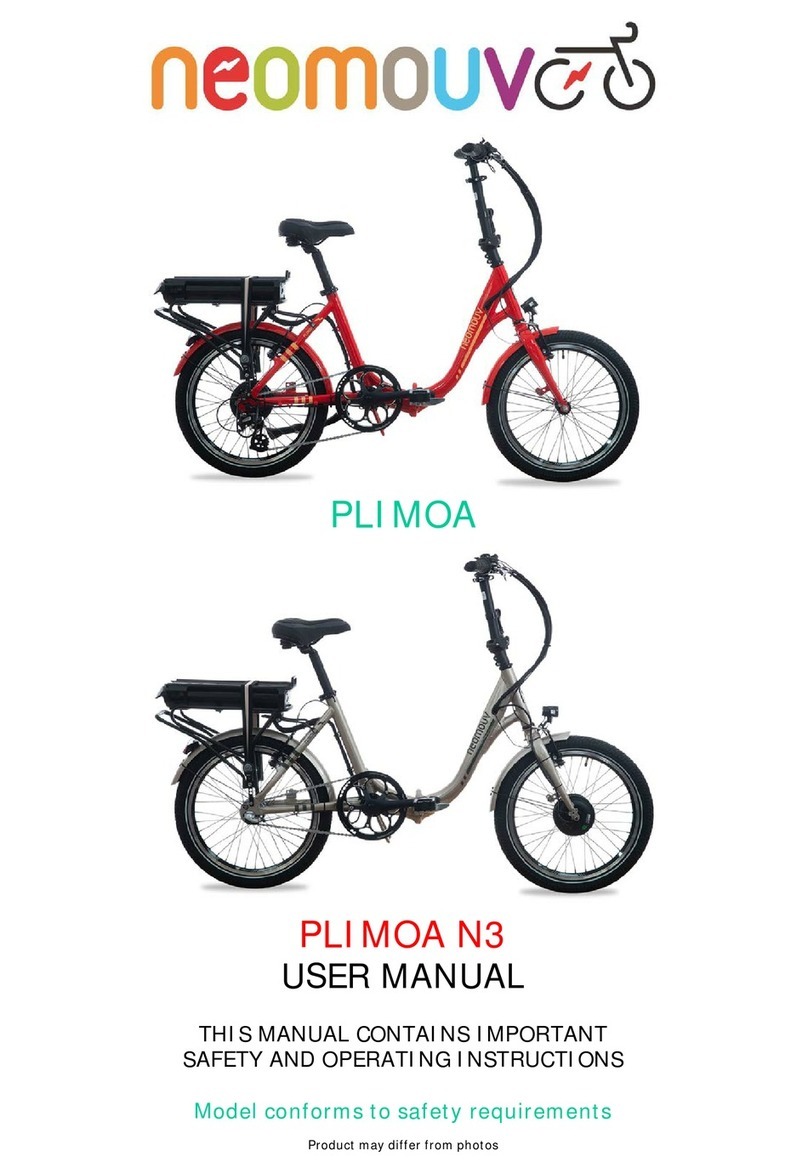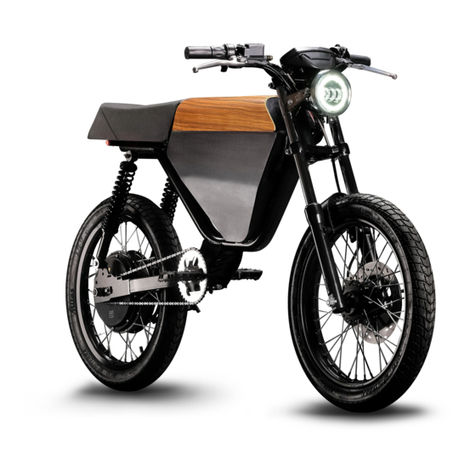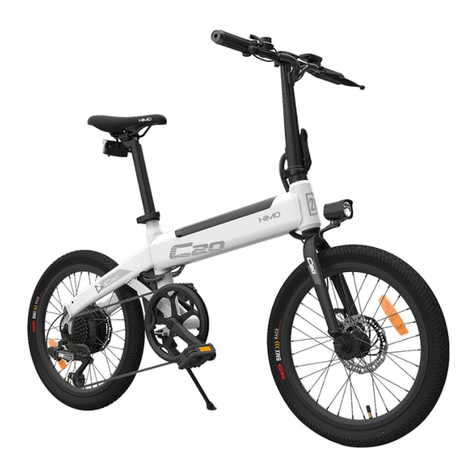e-motion Mini Pro User manual

Table of Contents:
Warnings 3
Definitions 6
Assembly instructions 6
Handlebar 6
Headlight & Front fender 7
Front wheel 8
Seat 9
Pedals 9
Brakes adjustment 10
Handlebar height adjustment 11
Mounting & dismounting of battery 13
Bike folding 14
Bike Inspection prior riding 15
The Display 15
Display settings 16
Error symbols 16
The battery & charger 17
Battery charge 18
Preserving battery lifespan 19
Tips for proper use 20
Bike maintenance 20
More info & contact us 21
.
2

3
Warning!
Cycling can be a hazardous activity even under the best of
circumstances. Proper maintenance of your bike helps reduce
the risk of injury.
Warning!
Ride the bike in a controlled environment away from cars,
obstacles, and other distractions at the first ride.
Warning!
Parental supervision is advised for use under the age of 16
Warning!
User must be aware and follow all traffic laws & regulations
Warning!
your bike is exposed to wear and tear as well as high
pressure. Various materials and components may react
differently to fatigue, wear or pressure. In case the life
expectancy of a certain component has expired, it may fail
unexpectedly and even cause injury to the user. !
Any form of cracking, deep scratching, discoloration etc.
are indications that the component integrity has expired,
and must be inspect by the dealer / manufacturer!
Warning!
Make sure that the brakes are well adjusted and work
perfectly before each ride. Check the brake pads before
each ride. Brake adjustment and maintaining must be
performed in a bike store, by qualified mechanic.
Warning!
Braking range influenced by many factors such as road
condition, weather, speed, carrying weight etc. plan your
stop accordingly.

4
Warning!
Accidents and falls may cause severe injuries and in
extreme cases even death!!
Read this user manual responsibly, with care and
judiciousness!!
Make sure that your bike is well assembled, well
maintained, and in a good condition according to this user
manual prior each ride!
Warning!
This model is equipped with automatic motor shut-off
system which controlled by the brakes. Make sure that the
system operates well before each ride. In case of system
failure, do not use the bike. have it repair at a certified
dealer.
Warning!
Cycling can be a hazardous activity even under the best of
circumstances. Wear protective gear such as a helmet and
other shields as well as closed shoes, even for a short ride!
Warning!
Avoid Storing of battery in extreme hot / cold temperature.!
Extremely low temperature may cause corrosion. and !
extremely high temperature may cause battery swell,!
which will make the battery dangerous, and even can cause
battery explosion!!
The recommended storage temperature for the battery is
between 50°-80°F.
Warning!
Do not leave the battery unattended in a closed vehicle!!
Such vehicle may warmed up by the sun and reach extremely
high temperature!
Warning!
Avoid exposing the battery to extreme temperatures (104°F or
higher) for prolonged period!

5
Warning!
The charger should be inspected before each charge.!
Inspect both electric cords for tears and make sure that the
inner wires aren’t exposed, check if charger’s body is melted,
and make sure that the output plug is not damaged!!
Do not use the charger if it’s damaged!
Warning!
DO NOT charge the battery without supervision!
DO NOT charge the battery overnight without supervision!!
Warning!
Improper assembly of the bike is dangerous, can cause bike /
component failure, resulting in injury to the rider! !
contact us for explanation if any of the instructions in this
manual are not clear to you or if you have any question. It is
highly recommended that a certified dealer will assemble the
bike.
Warning!
This bike model designed for roads and trails ride only. do not
use it for down-hills ride, jumps or decline stairs.
Warning!
This bike model designed to be used by a single grown rider
only. It is forbidden to use this bike by two users or more
together at the same ride. Child seat is suitable for this bike’s
rear rack as long as child weight not exceed 55 lbs. make sure
to use the child seat according to its manufacturer’s
Warning!
This bike model can carry up to 270 lbs total weight, rider &
belongings. Do not exceed this weight limit!

Definitions:
•PAS - Pedal Assist System - a sensor that located at the crank,
recognizes pedals movement and operates the motor accordingly to
the level which set on the display .
•TAG - Twist And Go - a throttle that located on the handlebar
activates the motor while twisted.
Assembly instructions:
Handlebar:
• Open the handlebar stem top lever.
• Slide-in the handlebar into the stem and lock the lever.
• Straight up the stem and lock it into its place, by clicking in the
folding mechanism lever.
6

• Adjust the handlebar so it will be aligned to the bike’s fork. Fold the
stem and tighten- up its central screw. Straight up the stem and
tighten -up both of its sides screws.!
!
!
!
!
!
!
2. Headlight & Front fender:
• Connect the headlight and the fender to the fork’s bridge.
• Connect both of fender support rods to the fork legs.!
7

3. Front wheel:
• Remove the guarding metal rod from the bottom of the fork, and pull
out the plastic spacer from the brake caliper.
• Slide in the wheel axis into the hub of the wheel while adding the
springs on hub’s both sides and screw its cup in.!
!
!
• Attach and locked the wheel to the fork by locking the axis lever.!
!
!
!
!
!
!
!
8
Warning!
The fork must hold the wheel in a way that the wheel does not
move to its sides or can be removed without opening the lever.
Warning! !
Make sure that the front fork turns easily sideways and not
jammed while you steer the handlebar. Make sure that the
bike's wires and brake tubes are not jammed or stretched
during steering.

4. Seat:
• Open the Frame’s seat tube lock and slide-in the seat post into it.
Lock the seat post by closing the lever.!
Make sure that the seat post is well locked and can’t move
sideways or up and down.!
!
!
!
!
!
!
!
!
!
!
!
!
!
!
5. Pedals:
• Assemble both pedals to the bike by screwing them to the crank &
crank’s leg. each pedal is marked with the correct side in which it
should be connected to the bike.!
9
Warning! !
In order to avoid frame breakage, make sure that seat post
safety line hidden by the frame seat tube.
Notice! !
For safe and comfortable riding, the rider should seat on the
bike while both feet toes touch the ground.

Brakes adjustment
Make sure that the brake pads are not rubbing or locking the front /
rear disc, while you're not pressing the brake-levers.
•In case in which the disc rubs / locked into the brake pads. Release
a bit both of the caliper screws (the screws that connect the caliper
to the fork), tightly press on the brake - lever and re-screw back the
screws into their place while continuously pressing on the lever. !
!
!
!
!
!
•!
• you can adjust the brake sensitivity by tightening / releasing of the
small Allen screw which located between the brake lever and the
handlebar.
10
Warning! !
It is highly recommended that the brakes will be adjust and
maintained by professional bike store!
Warning! !
Always check the brakes before using your bike and make sure
they are well operating.

Handlebar height adjustment
• Open stem top lever, adjust the height of the handlebar to the
desired position and lock it back into its place by closing the lever.
• You can change the angle of the handlebar by open and lock the
stem’s top lever. make sure to re-lock the lever before using the
bike.!
!
!
!
!
11
Warning! !
In order to avoid damage to stem that can lead for a sudden
breaking, always make sure that the handlebar’s tube marked
safety line is hidden from the eye while locking it into its place.
Warning! !
Make sure that the handlebar is well-locked in its new position,
by strongly pushing it down to the ground and turn it to the
sides.

Mounting & dismounting of battery
The battery switch has three modes:
(1) A mode in which the battery is shut off and it's unlocked to the
frame (in this mode you can pull out the battery from the bike or
placed it into the bike).
(2) A mode in which the battery is locked into the bike, and it’s
powered off.
(3) A mode in which the battery is locked into the bike, and it powered
on and ready for use.
• In order to switch the key from mode (2) to mode (1) the key should
be pushed into the battery
12
Warning! !
Make sure that while mounting the battery back into the frame,
the battery is sliding on its allocated rail, if the battery is
misplaced it may get stuck.

Bike folding
Handlebar folding: !
(1) Lower the handlebar to its lowest position,
and locked it.!
(2) Open handlebar’s stem bottom lever.!
(3) Fold down the handlebar
Handlebar Raising:!
(1) Straighten the handlebar. !
(2) Lock handlebar’s stem bottom lever by
clicking it into the stem. !
Frame folding:!
(1) Open the frame central folding lever. !
(2) Pull the lever towards the rear side
of the bike.!
(3) Lift up the lever
!
(4) Fold the frame
Return the frame to a riding position:!
(1) Lift up the frame central folding lever.!
(2) Return the frame to straight position!
(3) Lock the lever to its place.
13

Bike inspection prior riding:
•Check that the wheels are well connected to the frame / to the fork,
and that they are rotated freely.
•Check that the handlebar aligned with the front wheel, and all the
screws are tight.
•Check that there are no loose or missing spokes in the wheels.
•Check that all the bearings of the bike are rotating freely and not
damaged
•Check that the brakes are properly functioning, and that their pads
are not overly worn.
•Check that tires' air-pressure is same as the one that written on
them
•Check that the tires are not overly worn, worn tires will have no
proper road grip
•Check that the wheel rims are not broken or cracked.
•Check that the lights & horn systems are well functioning.
•Check that all components of the bike are well set in their place.
•Check that there are no pressure marks / cracks / discoloration
marks on the bike frame and on the front fork.
•Check that there is no visual damage on the bike’s battery.
•Check that the battery is properly mounted, and that it locked in the
bike's frame.
•Check that the TAG / PAS systems are properly functioning.
14

The display:
•Turn on / off the display power by long press on the button.
(make sure that the battery is on before turning on the display).!
•You can switch PAS speed levels by pressing on the &
buttons PAS level "0" - without support, PAS level "5"-
strongest support.
•Short press on the button will change the display’s shown
info!
•Long press on will activate the walking mode (the button
must be hold pressed, the walking mode will be terminated when
leaving the button).
•Long press on both & buttons will lead to the settings !
screen options. Short presses on button browse between the !
!
settings. Short presses on or buttons change the
15

setting’s info. In order to leave the settings screen long press both !
& buttons.
Display settings:
P01: Screen backlight level (1-3)!
P02: 0 - Km/h 1- MPH!
P03: Battery Voltage (24V/36V/48V)!
P04: Sleeping time (minutes for display automatically shuts - off) !
P05: DO NOT TOUCH!
P06: Wheel dimeter !
P07: Motor speed sensors, DO NOT TOUCH !
P08: Speed limit (input data in Km/h unites)!
P09: 0 – TAG works immediately, 1- TAG works only after PAS in use. !
P10: 0- Bike works with PAS only, 1- TAG only, 2- TAG & PAS!
P11: PAS sensitivity !
P12: PAS Start strength!
P13: PAS magnets (12 PAS magnets used in this bike, default) !
P14: Controller A (15)!
P15: Battery current voltage!
P16: ODO reset (long press on will reset the ODO)
Error symbols!
- Low voltage protection
!
- Controller failure
- Brake failure
- Throttle failure
- Motor failure
16

The battery & charger:
17
Warning!
Do not perforated or dropped the battery;
Do not placed the battery near to fire or another heat dispersing
element;
Do not soaked the battery in water;
Do not placed / use the battery at the vicinity of strong
electromagnetic or electrostatic fields;
Do not crushed or disassembled the battery.
Warning! !
Use the battery for its intended purpose. Do not use it for other
purposes, such use might be dangerous! Do not crushed or
disassembled the battery.
Warning! !
Keep away the battery and the charger from the reach of
children.
Important! !
The distance range of the bicycle in electric mode varies
according to rider's weight, road conditions, battery power etc.
The battery power diminishes with age (and with usage).

Battery Charge:
•Make sure that the battery is powered-off
•Plug the charger to the outlet first and then plug it to the battery.
•The charger red indicator light shows that the battery is in charging
process. When the red light turns into green, the battery is fully
charged.
•In order to disconnect the charger from the battery, unplug the
charger from the outlet first, and then unplug it from the battery.
18
Important! !
In case that the electric system is left on, !
while the bike is not in use for a long time, the battery may !
reach a state where it is no longer chargeable.
Important! !
Proper maintenance of batteries, according to !
this guide will maximize their lifespan and capacity.
Warning! !
Charge the battery with the original charger only. Using an
different charger is forbidden and dangerous!
Warning! !
Do not cover the battery and / or the charger during charging
process.
Warning! !
Terminate battery charging process immediately in case in which
the battery overheats during charging. In such case you must
Warning! !
Do not place the battery and / or the charger near flammable
substances.
Important! !
It’s recommended to charge the battery in full, prior to the first
use of the bike.

Preserving battery lifespan:
•make sure you charge the battery in full at least once in every 20
charging cycles
•Do not leave the battery discharged for more than 24 hours. Battery
that was left uncharged for a prolonged time, may reach a state in
which it cannot be chargeable
•In case in which the battery won't be in use for a significant time,
there is need to disassemble it from the bike and store it in a cool &
dry location. Make sure that the storage period won’t exceed 45
days without recharging the battery again.
•Average battery lifespan depends on its use and on its conditions.
Even with proper care, rechargeable batteries do not last forever.
This battery model will last between 700-1000 charging cycles.
Partial charging/discharge counts fractionally against those
numbers. Running the battery down halfway and then recharging it
completely, uses up to one half of a charge cycle.
19
Important! !
Batteries work better when they are fully charged. It is
recommended to start the ride while the battery is fully charged.
Important! !
Turn off the bike’s electric system when you're not riding the
bike.
Important! !
The battery cells are discharged autonomously,!
once the battery is left unused for a prolonged period.!
In cases battery cells are left low charged for a long period of
time, their charge cycles and capacity will diminish, and the
quality of the battery will be damaged.!
The battery should be left fully charged if it is not to be used for
a prolonged period.
Please! !
Be friendly to the environment! Batteries contain toxic
materials, be sure to recycle your old batteries at a local
battery-recycling center. !

Tips for proper use:
•Be aware that the right brake lever controls the rear brake, while
the left brake lever controls the front brake.
•Avoid braking using front brake only, as doing so may cause the
rider to be thrown forward from the bike. Always use both of the
brakes when you’re braking.
•Be aware that the brake range of the bicycle may prolong under
certain circumstances (e.g. wet/moist surface, sand, etc.)
•Do not ride your bike in water, puddles, rain, streams, etc.,
•Never immerse the bike in water, as the electrical system may get
damaged.
•Learn all relevant state laws as well all traffic regulations prior to
riding your bike and obey them.
•Always start your ride by pedaling and in low PAS level. In this way
you’ll control better the bike.
•Assist the motor by pedaling in up-hill climbs.
Bike maintenance:
•Do not oiled the battery or the motor.
•Oil the bike chain and the metal parts (which are not aluminum) on
a regular basis. The frequency of oiling your bike parts should be
more frequent in a humid / wet area.
•Use only original parts. Do not use substitutes parts unless they
permitted by Ecomotion Bike. please consult with us about
substitutes parts without consulting may void warranty.
•The bike should be cleaned using a moist rag only, DO NOT pour /
spray water directly onto the bike. After cleaning the bike, all metal
parts, should be oiled.
•All of bikes moving components and all bearings, should be
cleaned on a regular basis.
20
Table of contents
Other e-motion Bicycle manuals


